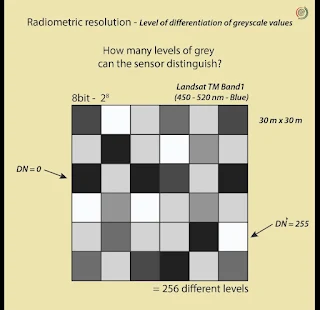In remote sensing, "eight-bit" and "sixteen-bit" refer to the number of bits used to represent the pixel values in an image. This affects the image's color or grayscale depth, which, in turn, influences the level of detail and precision in the image.
- Eight-Bit Image: An eight-bit image uses 8 bits per pixel to represent color or grayscale information. This means each pixel can have 2^8 (256) different possible values. In a grayscale eight-bit image, you have 256 shades of gray, ranging from black to white. In a color eight-bit image, you can represent a limited palette of 256 colors. Eight-bit images are suitable for basic visual interpretation but may lack fine detail and subtle color variations.
- Sixteen-Bit Image: A sixteen-bit image uses 16 bits per pixel, providing a significantly wider range of possible values, which is 2^16 (65,536). In remote sensing, sixteen-bit images are often used when high precision is required, especially in applications like land cover classification or analysis of subtle variations in terrain or vegetation. These images can represent a much broader range of colors or grayscale shades, making them ideal for detailed and accurate analysis.
In simple terms, the difference between eight-bit and sixteen-bit images in remote sensing is the level of detail and precision they offer. Sixteen-bit images can capture more information and nuances in the data, making them suitable for more advanced and accurate analysis, while eight-bit images are more basic and suitable for visual interpretation and simple applications.


Comments
Post a Comment